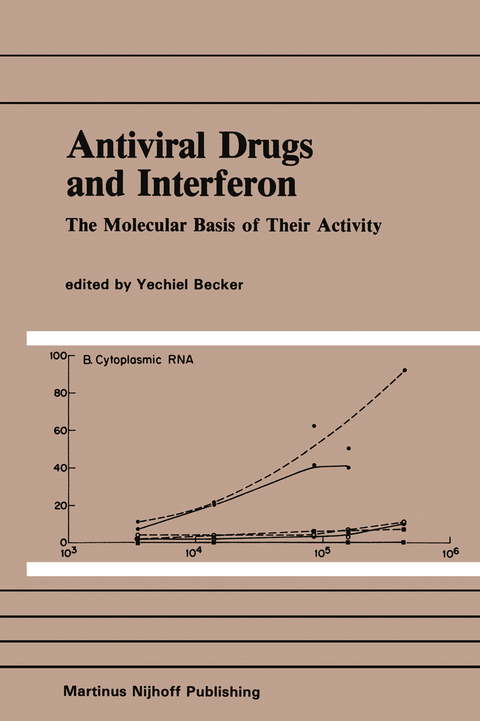
Antiviral Drugs and Interferon: The Molecular Basis of Their Activity
Kluwer Academic Publishers (Verlag)
978-0-89838-643-1 (ISBN)
Research on antiviral drugs and their mode of action in infected cells. in animals and in man. has led to a better understanding of the molecular pro cesses involved in virus replication. Screeninq of large numbers of natural and semisynthetic compounds resulted in the characterization of certain sub stances that had a limited efficiency as antiviral druqs. A few chemically synthesized compounds were also found to be effective as antiviral agents in the chemotherapy of human virus diseases. A major difficulty in the develop ment of effective antiviral agents has been the lack of selectivity. and toxicity for uninfected cells. of drugs that effectively inhibited virus replication in vitro. Further understanding of the molecular processes of virus replication in infected cells has resulted in the development of new antivirals directed at virus-coded enzymes or proteins. Recent studies on antivirals that are activated by the herpes simplex virus type l-coded thy midine kinase from a prod rug to an antiviral drug have opened new directions in the development of effective antiviral drugs. The present book deals with a number of antiviral drugs effective against herpes simplex viruses and provides some insight into the molecular aspects of virus replication. It also throws light on the new approaches to the development of antiviral drugs. The molecular basis of the antiviral activity of new and known drugs and their possible use in chemotherapy of viral disease are presented in this book.
Introduction: Current Trends in Research on Antiviral Drugs (a Review).- 1 Introduction: Current Trends in Research on Antiviral Drugs (a Review).- Antiherpes Simplex Virus Drugs.- 2 Antiviral Activity of Iodinated Pyrimidine Deoxyribonucleosides.- 3 Antiviral Properties of Aranucleosides: Metabolic Considerations.- 4 Herpes Simplex Virus Thymidine Kinase-Dependent Antiviral Agents.- 5 Acyclovir.- 6 BVDU ((E)-5-(2-Bromovinyl)-2’-deoxyuridine).- 7 (2’-Fluoro-5-iodo-1-?-D-arabinofuranosylcytosine) (FIAC): Synthesis and Mode of Anti-Herpesvirus Activity.- 8 Herpesvirus-Specified DNA Polymerase as the Target for Developing Selective Antiherpesvirus Agents.- 9 Phosphonoformate and Phosphonoacetate.- 10 Distamycin and Derivatives: the Pyrrole Amidine Antiviral Antibiotics.- 11 Clinical Insights into the Metabolism of Arabinosyl Adenine and Interferon as Derived by Microbiological Assays.- Drugs Inhibitory to Viral Reverse Transcriptase.- 12 Modulation of Retrovirus DNA Polymerase Activity by Polynucleotides and their Analogs.- Antipoxvirus Drug.- 13 Antipoxvirus Activity of Isatin-?-Thiosemicarbazone (IBT).- Drugs Affecting Synthesis or Processing of mRNA.- 14 Halogenated Ribofuranosylbenzimidazoles.- 15 Ribavirin.- Drugs Affecting RNA Viruses.- 16 Molecular Basis of Guanidine Action.- 17 Mechanism of Action of 2-(?-hydroxybenzyl)-benzimidazole (HBB).- 18 Multiple Actions of Amantadine Against Influenza Viruses.- Interferon.- 19 Polynucleotide Inducers of Interferon: Studies with poly(G)-poly(C).- 20 Interferon and Interferon-like Factors in Plants.- 21 The Interferon System in Man: Nature of the Interferon Molecules and Mode of Action.
| Reihe/Serie | Developments in Molecular Virology ; 4 |
|---|---|
| Zusatzinfo | XVI, 446 p. |
| Verlagsort | New York |
| Sprache | englisch |
| Maße | 155 x 235 mm |
| Themenwelt | Medizin / Pharmazie ► Medizinische Fachgebiete ► Mikrobiologie / Infektologie / Reisemedizin |
| Naturwissenschaften ► Biologie ► Mikrobiologie / Immunologie | |
| ISBN-10 | 0-89838-643-8 / 0898386438 |
| ISBN-13 | 978-0-89838-643-1 / 9780898386431 |
| Zustand | Neuware |
| Haben Sie eine Frage zum Produkt? |
aus dem Bereich


